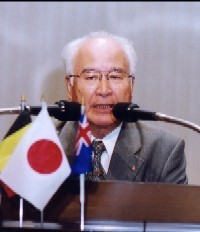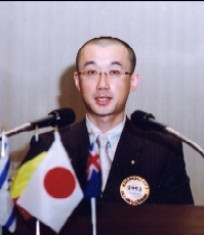Initiation��Speeches
July��28th��2004
President of Tosho Printing Co.ltd
Mr.Msaru Ito
The Successor Chief Priest
of the NIshi Arai Daishi Temple
Mr. Kenshin Hamano
 Printing and Electronics
Printing and Electronics
President of Tosho Printing Co.Ltd
Mr. ��asaru Ito
The basis of printing is to place on paper the information which should be offered to people. Light allows us to see the shapes of letters and forms.
��From 1900, photo-engraving became popular and held the field for some 50 years.From 1960 onwards, in step with the advent of color television, light was able to be treated as the strength of its impulses which were printed on photo-sensitive material.
��The color scanner appeared at this time. Ten years later, letters could be made by electronic impulses, and this is how the relations between electronics and printing emerged. In the 1980��s analogue communications became digital, and the making of plates for printing was revolutionized. High sensitivity photo sensors, computers, electronics with memory power became available and these all aided in the printing process. Today, nanotechnology ( nano = 1/1000 of a micron) has been put to use in printing used for the manufacture of ICs, LSIs and photomasks.
��In newspapers today the use of color pages is being quite common and there are cases where 16 out of 40 pages are in color. This color printing is done by using 6,000 yellow, red, blue and black dots per square centimeter, and the latest printing machines can print 180,000 copies an hour, or 50 copies per second.
��Formerly, photographs of the text and illustrations were used for making printing plates but today we use digital input to make these. The idea was to skip the steps of making printing plates and then use them for printing machines.
��The inkjet system which is used for printouts for digital cameras is used with instructions given electronically.
��By the use of electric beams and radar beams, the copier has come into being.
As the printing machines used by printing firms have data handling ability they can tap their data base and print a several hundred page book in an hour or less.
��With the advent of the broadband era together with the network information content can be obtained using cell phones and PDA which is called electronic publishing or electronic cataloguing. For the printing firm, making and maintaining data for such use becomes an important business as it is with information companies using print.
��Every advance in the ICs and LSIs used in electronic instruments poses a challenge to printing and plate making to the extreme. It is expected that such technologies will enhance the number of passages for electrons within a square millimeter with the use of nanotechnology.
 Two Buddhist Festivals,'Obon'and 'Ohigan'
Two Buddhist Festivals,'Obon'and 'Ohigan'
The Successor Chief Priest
of the NIshi Arai Daishi Temple
��Mr. Kenshin Hamano
����Obon�� comes from the Sanskrit language, and is a festival to allow the souls of the deceased to be freed from suffering in the next world and become Buddha. We, the descendants are therefore obliged to offer a prayer in gratitude for their sake.
��It is believed that the souls of the departed will return on August 13, so in the evening we light lanterns in front of our altars and burn a pyre in our garden or at the entrance to our homes. We place our ancestral tablet in the center front of our altars, and in most areas, bulls and horses made from cucumbers and egg plants are offered. This is done in order that the souls of the departed can come quickly riding on the horse and leave slowly on the bull. The souls of the departed stay with us for the 14th and 15th and leave on the 16th. We again burn fires in the evening in order to light the way for the departing souls.
��In some localities, this sending fire is done in a big way such as the burning of the ideograph meaning ��grand�� on a Kyoto mountainside, or the ��spirit boat�� of Nagasaki. One variation of this ritual is sending off small boats with lanterns and offerings.
��The ��Ohigan�� Festival is not observed in China or India, but is a Buddhist ritual peculiar to Japan. ��Ohigan�� is observed at the time of the vernal equinox and also the autumnal equinox. With the inclusion of three days preceding and 3 days after, a week is the time during which ��Ohigan�� is observed.
��Buddhism believes in a paradise in the West, and on the day of the equinox the sun rises due East and sets due West, and it is believed that when the sun sets in the West one��s prayers for deliverance are realized.
It is said that both the cold of winter and the heat of summer abate from the equinox, and it is timely for a celebration. Thus, ��Ohigan�� has become a part of our daily routine and more than a Buddhist ritual it has become a symbol of the seasons.
��At ��Ohigan��, we tidy up the altar and offer confectionary. We also visit our family graves to pay homage to our ancestors.Should there be a recently deceased among our relatives and friends, we visit their homes to offer flowers and burn incense at their altars, and it is said that should we conduct ourselves in accord with Buddhist practice during ��Ohigan�� time we will receive blessings from the Buddha. For the recently dead, let us offer prayers most sincerely for them and ancestors, but for our ownselves too.